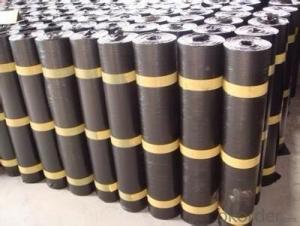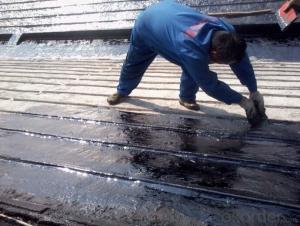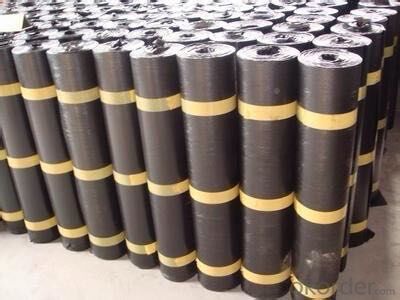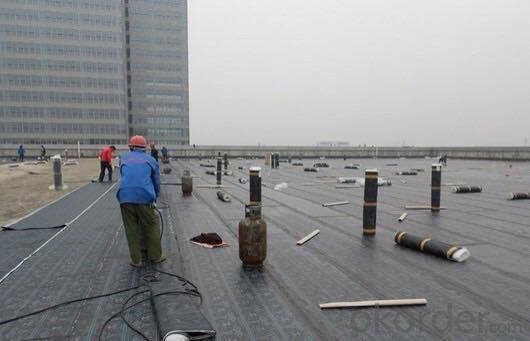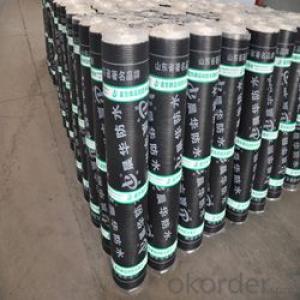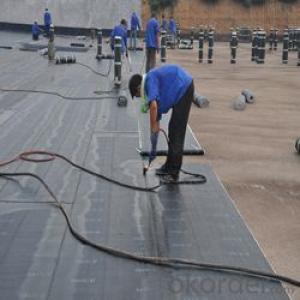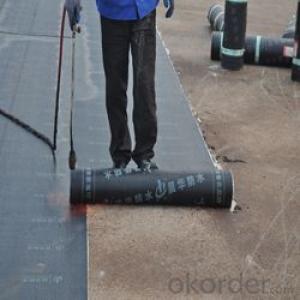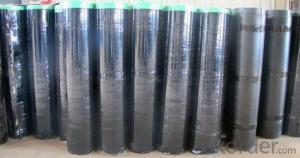Self adhesive SBS bitumen waterproof membrane
- Loading Port:
- Tianjin
- Payment Terms:
- TT OR LC
- Min Order Qty:
- 500 m²
- Supply Capability:
- 100000 m²/month
OKorder Service Pledge
OKorder Financial Service
You Might Also Like
Structure Of SBS Bitumen Waterproof Membrane Description
Self adhesive SBS bitumen waterproof membrane is produced with SBS elastomer and bitumen as raw materials, using polyethylene film. Aluminium foil coated on the upward or no file(both side self-adhesive) while self-adhesive protection layer on the downward surface.It has a widely prospect new contruction waterproof materials. Good self-adhesion, no leaking,cold flexibility,especially in self-adhesion. That is unique product in waterproof and application.
Main Features of the SBS Bitumen Waterproof Membrane
1. Self-adhesive without bonding agent and torching.
2. With good elasticity and elongation, can be used in -25 degree weather.
3. Easy and safe installation, and won't be effected by the weather, greatly reduce the construction period and the cost.
4. Environment protection product.
5. Corrosion resistance and ageing-resistance.
6. Available for wet ground.
SBS Bitumen Waterproof Membrane Images
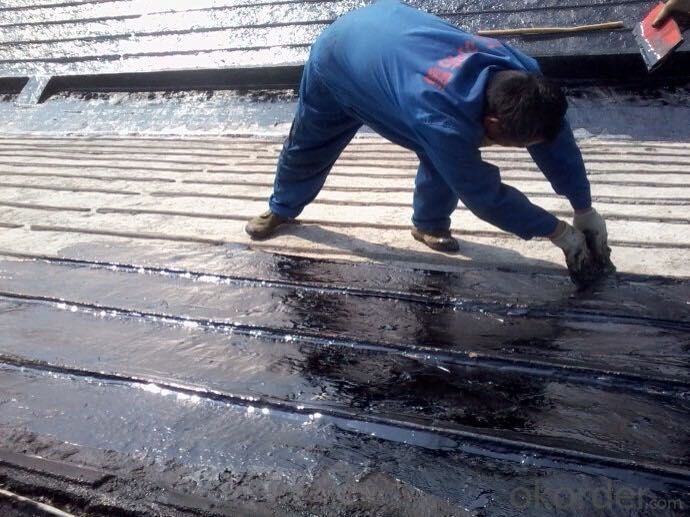
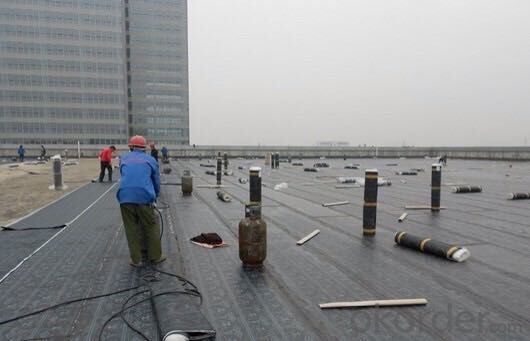
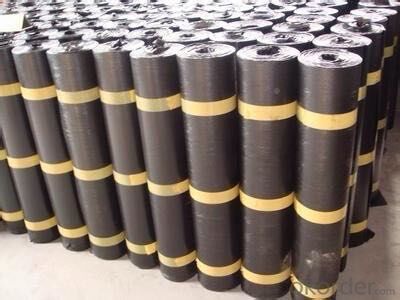
SBS Bitumen Waterproof Membrane Specifications:
1. Size: 1*10mm, 1*15mm, 1*20mm
2. Thickness: 1.5mm, 2.0mm, 3.0mm, 4.0mm
3. Weight: 25kgs, 26kgs, 32kgs, 38kgs.
4. Rolls in 1*20'GP: 800 rolls
FAQ Of SBS Bitumen Waterproof Membrane
1. What is the usage?
SBS/APP modified asphalt waterproofing membrane can be widely used for building surface and basement waterproof in industrial and civil engineering, as well as waterproof for subway, cold storage, airport runway and viaduct.
SBS modified asphalt waterproofing membrane is specially suitable to the architecture’s waterproofing in cold area and to the building of unstable constructions, while APP specially is suitable to areas of high temperature and of strong sunshine.
2. What is the application areas?
1. Balcony, bathroom, kitchen
2. Tunnels, Industrial roofs
3. Flat and sloped roofs
4. Basements, Foundation and retaining walls
5. Gardens, Bridges
- Q: Are waterproofing membranes resistant to high temperatures?
- The resistance of waterproofing membranes to high temperatures may vary depending on the specific material utilized. Certain waterproofing membranes are specifically engineered to endure high temperatures while retaining their effectiveness and integrity. These membranes often comprise materials like modified bitumen or synthetic rubber, which possess properties that enable them to withstand elevated temperatures. Nevertheless, it should be noted that not all waterproofing membranes possess resistance to high temperatures. Some membranes constructed from PVC or other thermoplastic materials may have limitations when exposed to extreme heat. Therefore, it is imperative to refer to the manufacturer's specifications and guidelines to ensure that the selected waterproofing membrane is appropriate for the intended application and can endure the expected temperature conditions.
- Q: Are waterproofing membranes suitable for rooftop gardens?
- Yes, waterproofing membranes are suitable for rooftop gardens. They provide an effective barrier against water leakage and prevent any potential damage to the structure below. Additionally, these membranes also protect the plants and vegetation in the rooftop garden from excessive moisture, ensuring their healthy growth.
- Q: Can a waterproofing membrane be used for wastewater treatment plants or sewage facilities?
- Yes, a waterproofing membrane can be used for wastewater treatment plants or sewage facilities. It helps to prevent water leakage, ensuring the containment and proper treatment of wastewater or sewage.
- Q: Can waterproofing membranes be used on precast concrete panels?
- Indeed, it is possible to employ waterproofing membranes on precast concrete panels. The vulnerability of precast concrete panels to water intrusion can result in detrimental moisture damage and concrete deterioration. To mitigate this, waterproofing membranes serve as an efficient solution by establishing a barrier between the concrete surface and the surrounding external conditions, successfully thwarting water infiltration. Normally, these membranes are administered on the outer surface of the precast panels, creating a safeguarding layer that thwarts water penetration through the concrete. Through the utilization of waterproofing membranes, precast concrete panels can attain enhanced durability, prolonged lifespan, and heightened resistance against moisture-related predicaments.
- Q: Can a waterproofing membrane be used in balconies or decks?
- Yes, a waterproofing membrane can be used in balconies or decks to protect the underlying structure from water damage and ensure a longer lifespan for the outdoor space.
- Q: Can a waterproofing membrane be used on balconies or decks?
- Balconies or decks can indeed benefit from the use of a waterproofing membrane. These membranes are specifically designed to offer a shield against water and moisture, making them an ideal solution for outdoor spaces that are constantly exposed to the elements. Their composition typically includes rubber, PVC, or bitumen, and they are directly applied to the surface of the balcony or deck. By doing so, they effectively prevent water from penetrating the underlying structure, safeguarding it against potential damage caused by moisture. Waterproofing membranes prove particularly advantageous in areas prone to heavy rainfall, snow, or high humidity, as they effectively prolong the lifespan of the balcony or deck by preventing water-related issues such as rot, mold, or deterioration. Moreover, these membranes also serve as an additional layer of protection against harmful UV rays, effectively preventing discoloration or fading of the balcony or deck surface. Ultimately, opting for a waterproofing membrane for balconies or decks is a wise investment that ensures their durability while maintaining their aesthetic appeal.
- Q: Are waterproofing membranes environmentally friendly?
- Waterproofing membranes can be environmentally friendly depending on the type of membrane used and how it is installed. Some waterproofing membranes are made from recycled materials, which reduces the demand for new resources and helps to minimize waste. Additionally, certain membranes are designed to be durable and long-lasting, which means they won't need to be replaced as frequently, reducing the overall environmental impact. However, it's important to consider the potential negative environmental impacts of waterproofing membranes as well. Some membranes are made from synthetic materials that may release harmful chemicals into the environment during production or when they degrade over time. Additionally, improper installation or disposal of waterproofing membranes can lead to pollution and contamination of soil and water sources. To ensure the environmental friendliness of waterproofing membranes, it is important to choose products that have been certified as sustainable or eco-friendly by reputable organizations. It is also crucial to hire experienced professionals who can install the membranes correctly, minimizing the risk of leaks or damage that could lead to environmental issues. Finally, proper disposal of old or damaged membranes is essential to prevent pollution and ensure responsible waste management. Overall, waterproofing membranes can be environmentally friendly if the right materials are chosen, installation is done properly, and disposal is handled responsibly. It is important to consider the environmental impact of these membranes and make informed choices to minimize any negative effects.
- Q: Are there any drawbacks or limitations to using a waterproofing membrane?
- Using a waterproofing membrane comes with its fair share of drawbacks and limitations. One issue is the time-consuming and labor-intensive installation process. These membranes require careful surface preparation and multiple layers, which can be both time-consuming and require skilled labor. As a result, the overall cost of the project may increase. Another limitation is that not all surfaces are suitable for waterproofing membranes. Certain membranes are designed for specific types of substrates, such as concrete or metal, and may not adhere properly to other materials. To ensure proper adhesion and effectiveness, it is crucial to select the appropriate type of membrane for the specific surface. Moreover, waterproofing membranes can be sensitive to environmental conditions. Exposure to extreme temperature fluctuations, UV rays, and chemicals can degrade the membrane over time, reducing its effectiveness. To ensure the longevity of the membrane, regular inspections and maintenance may be necessary. Furthermore, during installation or due to external factors such as foot traffic or heavy objects, waterproofing membranes can be susceptible to damage. Punctures, tears, or improper installation can compromise the integrity of the membrane and reduce its ability to prevent water infiltration. Lastly, in certain situations, waterproofing membranes may not completely prevent water penetration. If there are existing cracks or structural issues in the substrate, water may find a way to seep through, bypassing the membrane. Therefore, it is important to address any underlying structural issues before applying the membrane to ensure optimal performance. In conclusion, while waterproofing membranes offer significant benefits in terms of water damage protection, it is crucial to consider these limitations and drawbacks before deciding to use them in specific applications.
- Q: Is a waterproofing membrane resistant to extreme weather conditions?
- Yes, a waterproofing membrane is designed to be resistant to extreme weather conditions. It provides a protective barrier against heavy rain, snow, and intense sunlight, ensuring that it remains intact and effective in preventing water infiltration and damage to the underlying structure.
- Q: Can a waterproofing membrane be used for a foundation?
- Yes, a waterproofing membrane can be used for a foundation. Waterproofing membranes are designed to provide a barrier against water infiltration and can be used to protect the foundation from moisture damage. These membranes are typically made from materials such as bitumen, rubberized asphalt, or polymer-based sheets that are installed on the exterior side of the foundation walls. They are designed to prevent water from seeping into the foundation, which can help to prevent potential issues such as water damage, mold growth, and structural deterioration. It is important to ensure that the waterproofing membrane is properly installed and meets the specific requirements of the foundation to ensure its effectiveness.
Send your message to us
Self adhesive SBS bitumen waterproof membrane
- Loading Port:
- Tianjin
- Payment Terms:
- TT OR LC
- Min Order Qty:
- 500 m²
- Supply Capability:
- 100000 m²/month
OKorder Service Pledge
OKorder Financial Service
Similar products
Hot products
Hot Searches
Related keywords
